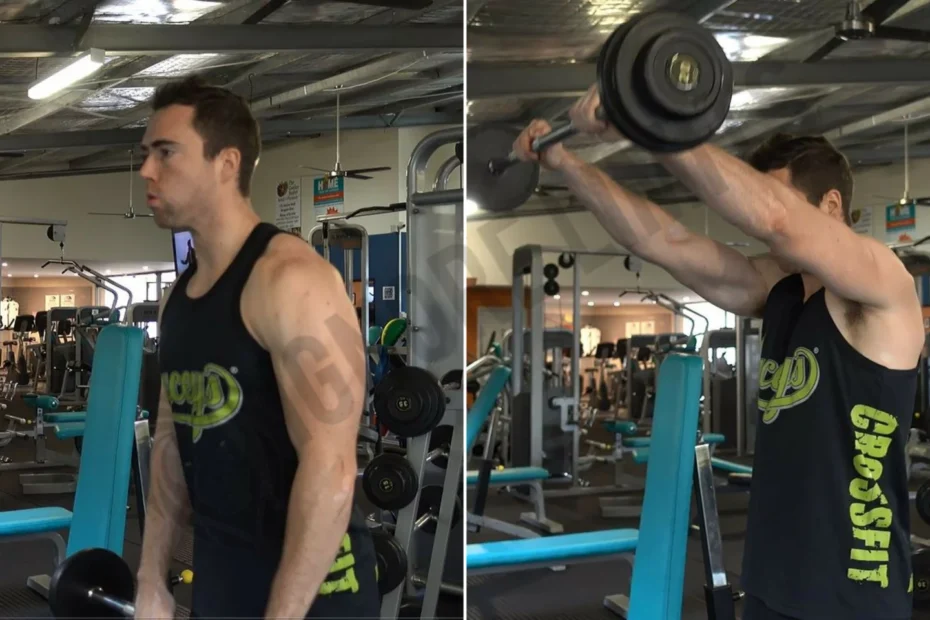The barbell front raise is an effective shoulder exercise that primarily targets the anterior deltoid muscles. In this comprehensive guide, we’ll explore how to perform barbell front raises correctly, the muscles worked, the benefits they offer, common mistakes to avoid, and variations & alternatives to enhance your shoulder training.
Muscles Worked
Primary Muscles Targeted:
- Anterior Deltoids (Front shoulder muscles)
Secondary Muscles Engaged:
- Lateral Deltoids (Side shoulder muscles)
- Triceps (Back of the upper arm)
How to Do Barbell Front Raises
Follow these steps to perform barbell front raises correctly:
- Starting Position: Stand with your feet shoulder-width apart, knees slightly bent. Hold a barbell with both hands in an overhand grip (palms facing down). Let the barbell rest against the front of your thighs.
- Body Position: Keep your back straight, chest up, and core engaged. Your head should be in a neutral position.
- Lift the Barbell: Inhale and slowly lift the barbell in front of you with straight arms. Keep a slight bend in your elbows to prevent strain on your joints.
- Raise to Shoulder Level: Continue to lift the barbell until it reaches shoulder level or slightly below, parallel to the ground. At the top of the movement, your arms should be straight, and the barbell should be at shoulder height.
- Lower the Barbell: Exhale and slowly lower the barbell back to the starting position, maintaining control.
- Repetition: Perform the movement for a specific number of repetitions or a set duration.
Benefits of Barbell Front Raises
Barbell front raises offer several benefits for your shoulder development and overall fitness:
- Anterior Deltoid Focus: This exercise primarily targets the anterior deltoid, helping you build strength and definition in the front of your shoulders.
- Secondary Muscle Engagement: The lateral deltoids and triceps are also engaged, providing a well-rounded shoulder workout.
- Functional Upper Body Strength: Developing strong anterior deltoids contributes to improved upper body strength and performance in various activities and sports.
- Improved Shoulder Aesthetics: Strengthening the front of your shoulders can enhance the aesthetics of your upper body.
Common Mistakes to Avoid
To maximize the effectiveness of barbell front raises and minimize the risk of injury, be mindful of these common mistakes:
- Swinging the Barbell: Perform the exercise in a controlled manner, avoiding any swinging or jerky movements.
- Using Excessive Weight: Start with a manageable weight to ensure you can maintain proper form and prevent shoulder strain.
- Overarching Your Back: Keep your back straight and avoid arching it excessively during the movement.
- Using Momentum: Use your shoulder muscles to lift the barbell rather than relying on momentum.
Variations & Alternatives
Variations:
- Dumbbell Front Raise: Use dumbbells instead of a barbell for unilateral training or to vary your range of motion.
- Plate Front Raise: Hold a weight plate with both hands in a similar fashion to a barbell and raise it in front of you.
Alternative Shoulder Exercises:
- Standing Military Press: Press a barbell or dumbbells from shoulder height to overhead, engaging multiple shoulder muscles.
- Arnold Press: A seated dumbbell press that involves a rotational motion, engaging various shoulder muscles.
- Lateral Raises: Isolate the lateral deltoids by lifting dumbbells to the sides of your body.
- Barbell Shrugs: Target the upper trapezius muscles by lifting a barbell with both hands while shrugging your shoulders.
Incorporate barbell front raises or their variations into your shoulder training routine to develop strong and defined shoulders, improve upper body strength, and enjoy the benefits of a well-conditioned upper body.
